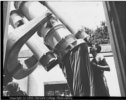George Champine HCO-DASCH Logbook Archive
The purpose of the DASCH Logbook Imaging Project is to generate a set of images of the Harvard collection of astronomy logbooks. These images enabled transcribers working at home to create a data base of the information in the logbooks. The project to image the logbooks started in early 2006 and was accomplished by George Champine whose report appears below. We regret that George Champine passed away on March 25, 2013.
To access logbook photographs use the logbook browser.
Determining Optimum Photographic Parameters
The first step on the project was to run a set of experiments to determine the optimum resolution and other photographic parameters. After a number of experiments of creating images of differing resolution, it was determined that a resolution of 1500 by 2000 was more than adequate to represent all of the legibility of the handwritten logbook entries without pixilation for a page size of 10 inches by 15 inches.Equipment
A copy stand was constructed with three lights. Wood guides were attached to allow quick and accurate positioning of the logbook under the camera. Illumination was 400 watts at 22 inches. A camera-to-logbook distance of 21 inches was used to minimize off-axis distortion and yet obtain adequate image size. Images were captured with a Nikon Coolpix 995 with resolution of three million pixels. The camera was set to: manual mode, monochrome image, image sharpening, and image contrast increase. Automatic exposure was used, which was 1/30 second at F7.9. Auto focus was used to compensate for varying image distance as the logbook pages were turned. A foot-operated shutter release was constructed to speed operation and so that pages could be held flat manually. Each image is a JPG file about 0.6 MB in size.File Naming
The page image file names that came from the camera were renamed so that the first part of the file name was the name of the logbook, and the last part was the left page number of the double page. This assures that each image can be unambiguously related to its source logbook and page. Since there are both bound and unbound logbooks, a letterbdesignates a bound book and a letter
udesignates an unbound logbook. The logbook cover image is always the first image in the folder and always has file number
-0000, giving a file name for example
rh17b-0000. If there are notes on the inside of the cover, that image always has number
-0001. Each subsequent image is numbered the same as the left page in the image. Thus the image of pages 200-201 in logbook RH17 has file name
rh17b-0200. The Bulk Rename Facility software was used to do the initial renaming, followed by a perl script. The renaming also provided a consistency check to make sure there were no missing pages or duplicated pages.
Folder Naming
The files are stored on the web server in a directory tree:- The top level directory is named
logs
. - The second level directory is named after the plate series.
- The third level directory is named with the volume number prefixed by a
b
for bound volumes andu
for unbound volumes

